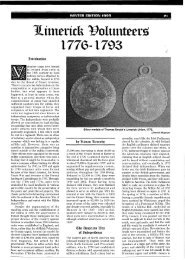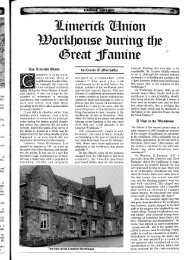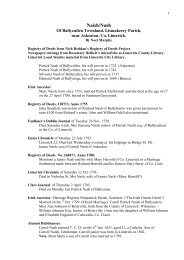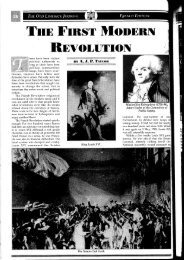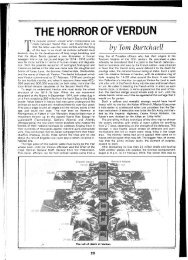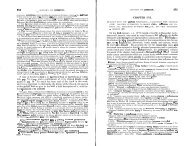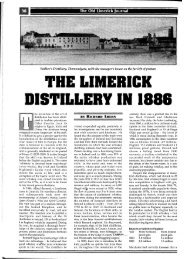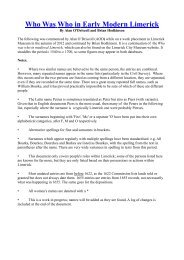The House of Industry by Paddy Lysaght - Limerick City Council
The House of Industry by Paddy Lysaght - Limerick City Council
The House of Industry by Paddy Lysaght - Limerick City Council
You also want an ePaper? Increase the reach of your titles
YUMPU automatically turns print PDFs into web optimized ePapers that Google loves.
<strong>The</strong> <strong>House</strong> <strong>of</strong> <strong>Industry</strong><br />
<strong>by</strong> <strong>Paddy</strong> <strong>Lysaght</strong><br />
<strong>The</strong> foundation stone <strong>of</strong> the <strong>House</strong> <strong>of</strong> <strong>Industry</strong>, laid in 1774.<br />
<strong>The</strong> building now known as the Strand Barracks, used<br />
since the mid'-thirties <strong>by</strong> the <strong>Limerick</strong> Corporation as<br />
its main depot and stores, has a long and interesting<br />
history. A study <strong>of</strong> this history tells us much about social<br />
conditions in <strong>Limerick</strong> since the date <strong>of</strong> its foundation as<br />
far back as 1774 as the <strong>House</strong> <strong>of</strong> <strong>Industry</strong>, to its closure<br />
some time after 1842 when the first Union Workhouse for<br />
<strong>Limerick</strong> was opened for the reception <strong>of</strong> the poor.<br />
Facing page 223 <strong>of</strong> Ferrar's History <strong>of</strong> <strong>Limerick</strong>, 1787,<br />
is a line engraving <strong>of</strong> the <strong>House</strong> <strong>of</strong> <strong>Industry</strong>. Its frontage<br />
is impressive and well proportioned, with two blind win-<br />
dows or niches and a neat doorway in the lower story. <strong>The</strong><br />
second storey contains eleven windows. <strong>The</strong> outward<br />
facade <strong>of</strong> the building is still extant but it has been van-<br />
dalised <strong>by</strong> the breaking down <strong>of</strong> the original doorway so<br />
as to enlarge it for the passage <strong>of</strong> large vehicles, and the<br />
building work above this enlarged doorway can only be<br />
be described as an eye-sore -p a plastered, white painted<br />
wall which has completely destroyed the appearance and<br />
line <strong>of</strong> the cut stone building<br />
<strong>The</strong> <strong>House</strong> <strong>of</strong> <strong>Industry</strong> owes its inception to an act<br />
passed in the Irish <strong>House</strong> <strong>of</strong> Commons in 1772, es-<br />
tablishing Poor <strong>House</strong>s and Work <strong>House</strong>s in every county.<br />
As a result <strong>of</strong> this act, in 1773 the County and <strong>City</strong> grand<br />
juries <strong>of</strong> <strong>Limerick</strong> presented £500.00 for the erection <strong>of</strong><br />
such an establishment in the city, and the Protestant<br />
Bishop Gore granted the land for the building on the<br />
North Strand.<br />
On March 10, 1774 the Mayor Joseph Johwattended <strong>by</strong><br />
the Corporation, led a procession to the site and laid the<br />
first stone. <strong>The</strong> building was completed in the following<br />
year, and, according to Ferrar's contempory description,<br />
It is light and handsome, forming a large square built<br />
in courses, ornamented in front with cut stone; con-<br />
tains 16 large rooms, with an Infirmary at the foot <strong>of</strong><br />
the garden in the rere <strong>of</strong> the house, and a number <strong>of</strong><br />
cells for lunatics, to the latter <strong>of</strong> which purpose<br />
£200.00 were given <strong>by</strong> the late Dr. E. Smythe <strong>of</strong> the<br />
city <strong>of</strong> Dublin.<br />
Ferrar then proceeds to eulogise on the benefits the<br />
new institution will confer <strong>of</strong> the city: "What could be<br />
better conceived", he writes, "than to support the aged<br />
and the feeble poor, to save helpless infants from<br />
perishing, to take care <strong>of</strong> lunatics ... and to make the<br />
sturdy vagrant useful to society <strong>by</strong> his labour?". <strong>The</strong><br />
building was also used to house "young females who for<br />
want <strong>of</strong> employment might become the victims <strong>of</strong><br />
pr<strong>of</strong>ilgancy and vice".<br />
It seemed all very meritorious to house the aged poor,<br />
deserted children and the rest, but there is an omnious<br />
ring about the phrase "making the sturdy vagrant useful<br />
to society <strong>by</strong> his labours". <strong>The</strong>re is even evidence to
suggest that people were <strong>of</strong>ten forced into the institution,<br />
simply because they were unable to find work outside.<br />
T.\e temptation must have been there to recruit sturdy<br />
people who could work rather than the aged poor and<br />
deserted children. It would appear that young females<br />
out <strong>of</strong> work were also sent to the institution for the<br />
strange and illogical reason that they might otherwise<br />
fall <strong>by</strong> the wayside.<br />
For ten or fifteen years after the <strong>House</strong> <strong>of</strong> <strong>Industry</strong><br />
opened it would appear that life was tolerable enough for<br />
the inmates. <strong>The</strong> funds for its support from the grand<br />
juries' presentments, plus several donations and sub-<br />
scriptions, were more or less adequate. Ferrar gives the<br />
following details <strong>of</strong> the inmates for the year 1787; aged<br />
and infirm 41 ; poor, able to work, 35; lunatics 12: in all,<br />
88. <strong>The</strong> pre-Famine increase in the population <strong>of</strong> the city<br />
inevitably meant an increase in the population <strong>of</strong> the<br />
<strong>House</strong> <strong>of</strong> <strong>Industry</strong> as well. In 1827 we find it contained 450<br />
inmates, who, despite some additions to the original<br />
building, were now "crowded to excess, and the yards for<br />
exercise encroached on to such a degree, as to contract<br />
them beyond what they should be in point <strong>of</strong> space". And<br />
because the adjacent lands were Church property or in<br />
private hands, there was no possibility <strong>of</strong> purchasing<br />
further ground for enlar ing the institution.<br />
As early as 1801 we fin d that Rev. Foster Archer, in his<br />
capacity as His Majesty's Inspector <strong>of</strong> Prisons, visited<br />
the house and reported:<br />
... <strong>The</strong> <strong>House</strong> <strong>of</strong> <strong>Industry</strong>, where an inhuman practice<br />
prevails <strong>of</strong> putting chains and heavy logs on vagrants,<br />
sick and well, industrious and idle, orderly or riotous.<br />
I had those chains removed from the diseased and the<br />
industrious and well behaved. This . . . . . . . .<br />
practice <strong>of</strong> chaining human creatures is very<br />
reprehensible. It covers an oppressive system <strong>of</strong><br />
making the wretched beings pay the Beadle for tak-<br />
ing them <strong>of</strong>f.<br />
Shades <strong>of</strong> Dickens, but it would appear that the beadles<br />
he portrayed in his writings never stooped as low as their<br />
counterpart in the <strong>House</strong> <strong>of</strong> <strong>Industry</strong>.<br />
In 1805 Sir John Carr in his Tour <strong>of</strong> Ireland described<br />
his visit to <strong>Limerick</strong>, and he found the <strong>House</strong> <strong>of</strong> <strong>Industry</strong>,<br />
"A gloomy abode <strong>of</strong> mingled want, disease, vice and<br />
malady, where lunatics were loaded with heavy chains<br />
and fallen women bound and logged".<br />
By, 1828 the conditions <strong>of</strong> the inmates would ap ear to<br />
have improved, if we take the words <strong>of</strong> Elizabeth d' ry, the<br />
great prison reformer at their face value. In that year she<br />
and her brother visited the house, and in the words <strong>of</strong> her<br />
brother, "Visited this useful institution in company with<br />
my sister, Elizabeth Fry, and we are much pleased with<br />
it. It appears extremely desirable that the worthy klderman's<br />
Watson's efforts should be yet more extensively<br />
supported ..." Andrew Watson was, apparently, a consistent<br />
worker on behalf <strong>of</strong> the house.<br />
An 1825 report on the independent schools in <strong>Limerick</strong><br />
showed that there were two schools, sponsored <strong>by</strong> the<br />
Protestant Kildare Place Society, in the house. Seventytwo<br />
girls and seventy-one boys were being educated there.<br />
From a statement <strong>of</strong> the income and expenditure <strong>of</strong> the<br />
house in 1840 we learn that there were 567 people in the institution.<br />
At this date it was over £700.00 in debt and the<br />
governors made an appeal to the grand juries to<br />
sum adequate to the support <strong>of</strong> this excellent c $ant arity". "a<br />
But such an amount was not forthcoming. In the previous<br />
year, presentments from the city and county, pJus donations<br />
only came to over £1,200.00 - a pitiful sum when<br />
one remembers that there were more than 500 inmates to<br />
be cared for. An examination <strong>of</strong> the income and expenditure<br />
<strong>of</strong> the house for 1839-'40 is so interesting that it is<br />
W<br />
worth giving in full. (See appendix).<br />
Some <strong>of</strong> the rules <strong>of</strong> the house bring home the<br />
harshness and poverty <strong>of</strong> the times. At night fall a bell<br />
was rung, when all the inmates had to retire to their<br />
respective wards, where they were locked up until morn-<br />
ing. After a breakfast <strong>of</strong> porridge and new milk, all the<br />
able-bodied went to their respective occupations - weav-<br />
ing, spinning, opening up hair for upholsterers and oakum<br />
for ship chandlers. A third <strong>of</strong> the pr<strong>of</strong>it from these<br />
l
labours was given to the workers, a quarter to the house<br />
steward and the remainder to the funds <strong>of</strong> the institution.<br />
Dinner consisted <strong>of</strong> potatoes and sour milk, meat being<br />
seldom available as funds were not sufficient to buy it.<br />
Misconduct was punished <strong>by</strong> confinement and deprivation<br />
<strong>of</strong> food. It is also worth notin that there was no<br />
provision for a resident doctor or c ergyman and these<br />
functions were performed voluntarily <strong>by</strong> some charitably<br />
disposed doctors and clergymen <strong>of</strong> both the Church <strong>of</strong><br />
Ireland and Roman Catholic denominations.<br />
In the same period visits to the house were made <strong>by</strong> the<br />
Sisters <strong>of</strong> Mercy from St. Mary's Convent. With the<br />
transfer <strong>of</strong> inmates to the <strong>Limerick</strong> Union, the nuns con-<br />
tinued their visitations at that institution.<br />
It can be said that the <strong>House</strong> <strong>of</strong> <strong>Industry</strong>, because <strong>of</strong> in-<br />
adequate funds and the increase <strong>of</strong> population in pre-<br />
Famine times never lived up to the high hopes <strong>of</strong> its foun-<br />
ders. For the first few years <strong>of</strong> its existence donations,<br />
coupled with presentm&s, kept its head above water.<br />
Besides, the number <strong>of</strong> inmates was not great. But, as<br />
usually happens, donations gradually declined. Whereas<br />
early on it was the thing to do to give donations, interest<br />
in the house quickly waned. <strong>The</strong> gentry returned to their<br />
panelled drawing rooms and their hunts and balls, where<br />
the poor and their plight were out <strong>of</strong> sight and very much<br />
out <strong>of</strong> mind.<br />
f<br />
Civil War damage to the front <strong>of</strong> the <strong>House</strong> <strong>of</strong> <strong>Industry</strong> in<br />
1922.<br />
<strong>The</strong> institution was, no doubt, a blessing to some <strong>of</strong> the<br />
poor wretches that found shelter under its ro<strong>of</strong>. <strong>The</strong>y had<br />
little choice: either the hell <strong>of</strong> their filthy and overcrow-<br />
ded garrets, or the lesser evil, the comparative opulence<br />
<strong>of</strong> the <strong>House</strong> <strong>of</strong> <strong>Industry</strong>, where, if they were lucky, they<br />
may have escaped chaining and logging, and if the beadle<br />
<strong>of</strong> the time was not too corrupt, the few paltry coppers<br />
they earned may not have been given with one hand and<br />
taken away with the other.<br />
S'P'rl%BXE~T EXPENDITURE,<br />
OF THE INCOUE -&VD EXPEXDZTURE OP S S. - d.<br />
<strong>The</strong> <strong>House</strong> OX Zndustry,<br />
LIMERICS,<br />
FROM 11~1 JUNE, 1839. TO 1 1 1-WARY, ~ ~<br />
Balance c!ie to %ensurer, 11 th June, 1839, 288 1A 1<br />
Potaioes, . £283 4 9<br />
!U ilii,<br />
1840. . . 343 12 4<br />
Ootmed, . . 452 5 5<br />
ISCOME.<br />
<strong>City</strong> Presentment, granted S a. d. f: r. d.<br />
Spring Assizes, 1839, 49.2 6 1<br />
Bdwnce on <strong>City</strong> Presentment<br />
,g-anted Summer Assizes,<br />
1839, paid <strong>by</strong> order <strong>of</strong> the<br />
Chief Remembrnncer, 100 0 0<br />
County Presentment. granted<br />
Spring ,S3Qize~ ?S33 500 0 C<br />
Re-preqeniic~n', made <strong>by</strong> Co.<br />
Gr ~ I~JLF, Spria~ Asuizes,<br />
1830. .. .. .. 100 0 0<br />
1192 6 (i<br />
DO;T%TIONS.<br />
From Lord Lieutenant, . 5 0 0<br />
D. A. Leahy, Esq. 20 0 0<br />
B. F. Fethard, .. 3 0 0<br />
Mr. Danson, .. l l 0<br />
Wm. Dunbar, Esq. I 0 0<br />
Samuel Wiion, Esq. l 0 0<br />
Thos. MiNamasa, Esq. 10 0<br />
31i33 lIaunsel1, . . 1 0 0<br />
Rev. Dr. Townley, l 10 0<br />
Rev. Thos. X'Donnell,<br />
Restitution Money,<br />
per Captain Kane 4 8 0<br />
38 1 l<br />
Xcceived Imtalment <strong>of</strong> Xrs. Banks'<br />
Cnarity . . . . 17 10 0<br />
Bread, . . 42 19 0<br />
Meat, . --- 21 13 0 117'1 14 g<br />
'uei. from January 18333. , .. 236 10 0<br />
Clothing, . . 20 l2 9<br />
5 km, . . 15 12 7<br />
Soap, Candles and Salt, . . 65 11 4<br />
S:a:io-nsry, . . . I0 11 9<br />
lizabing and Glwicg for txo years, 38 I7 2<br />
L.



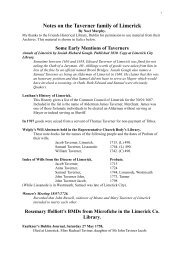

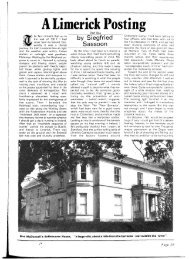
![The Galbally farmer [poem] by Darby Ryan - Limerick City Council](https://img.yumpu.com/24792577/1/190x260/the-galbally-farmer-poem-by-darby-ryan-limerick-city-council.jpg?quality=85)
